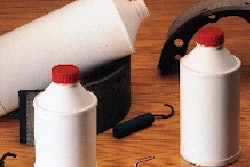Glass, the study shows, does have class, as the industry has been telling us for years. And some product categories-wine, liquor, beer, perfume, to name a few-might lose some of their consumer appeal in containers other than glass. Contrary to what you might assume, the study wasn't done by the Glass Packaging Institute. Nor was it done to promote glass over other container materials, although the subtext of the study gives solid testimony to the quality and inherent value consumers ascribe to glass. The study was commissioned by D.G. Demptos Glass Co., LLC (Louisville, KY), a container distributor who has customers in the wine business. Demptos asked market researcher Barry Bone Group (San Francisco, CA) to study responses to this question: "How does the consumer buy his/her wine, and what role does packaging play in this decision?" What the Demptos study determined is that for at least 28% of American wine consumers, packaging is a decisive factor, perhaps the determining factor, in the purchasing decision. If wine is being purchased as a gift, the influence of packaging on the purchasing decision shoots up to 67%. The Demptos study is particularly interesting because the research panel was made up of consumers from Los Angeles and San Francisco who drink more than two glasses of wine per week. This group, reasoned the researchers, is the "ideal" to study. They're Californians who are regular users of the product and therefore can be assumed to have an above-average knowledge of the main wine-growing areas of the U.S. These consumers "could be expected to be the most knowledgeable about wine and therefore the least influenced by factors other than the type and brand involved," says Godert G. Tegelberg, president and CEO of Demptos Glass. Here's what Demptos learned. About publicity: Advertising works, but only to a limited extent and at a high cost. Of the consumers questioned, most couldn't recall more than two brands of wine, 73% couldn't come up with more than three and none could name more than five brands. Brands with the largest ad budgets had the highest recalls. For example, Gallo had a 21% brand recall, Beringer 20%, Robert Mondavi 20% and Sutter Home 18%. About point of sale: Fully 72% of the self-acclaimed wine connoisseurs in the Demptos study admit they purchase on impulse. And 90% "can give a surprisingly detailed description of the package that they usually buy, down to type of closure, labels, bottle shape, color, et al," says the study. About pricing: The study determined that pricing is a constraint more than a positive reason to buy a given wine. "A large number of purchasing decisions are made in front of the shelf, influenced only by factors within the store, such as shelf position, information given by sales clerks, shelf-talkers and packaging," concludes Demptos. "Consumers are sensitive to packaging, both at the time of purchase and in terms of retention and recognition." A specific cue for the wineries is Demptos' finding that: "The exclusive use of traditional wine bottle shapes that we have borrowed from the European wine industry, and that denote a certain region or taste, may be inappropriate for the U.S. market. The package should reflect the flavor of the wine instead, and appeal to its target group." To request a copy of the research, phone Demptos at 502/394-9298. Ben Miyares is vice president and editorial director of the newsletter Packaging Management. He may be reached at 31408 Narragansett Lane, Bay Village, OH 44140. Telephone: 216/892-0998; Fax: 216/892-0208; e-mail: [email protected].
Study confirms bottles affect wine buying
A recent study on American wine purchasing shows that glass wine bottles play a key role in determining which wine is purchased. Marketers considering dropping glass in favor of some other packaging material would do well to analyze the study-perhaps even duplicate it in their own product categories-before making a move.
Dec 31, 1996
Companies in this article
Machinery Basics
List: Digitalization Companies From PACK EXPO
Looking for CPG-focused digital transformation solutions? Download our editor-curated list from PACK EXPO featuring top companies offering warehouse management, ERP, digital twin, and MES software with supply chain visibility and analytics capabilities—all tailored specifically for CPG operations.
Download Now
Annual Outlook Report: Workforce
Hiring remains a major challenge in packaging, with 78% struggling to fill unskilled roles and 84% lacking experienced workers. As automation grows, companies must rethink hiring and training. Download the full report for key insights.
Download Now
Downloads























